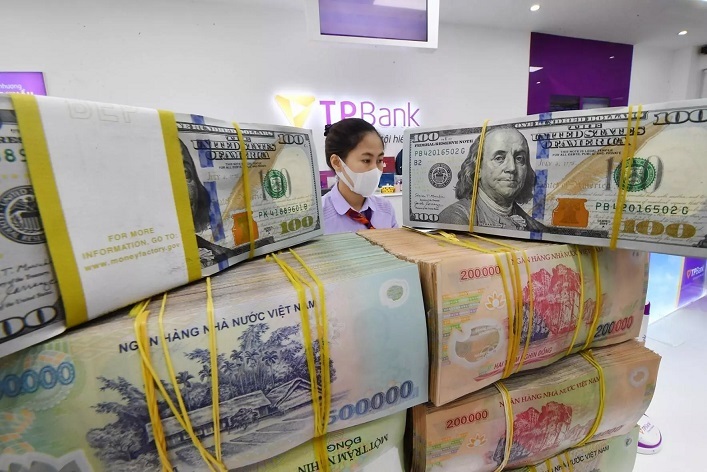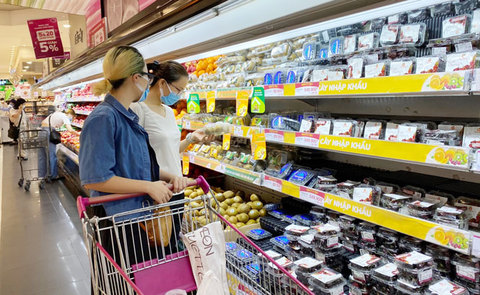 |
|
|
The Bank of Canada (BoC) has decided to keep its key lending rate unchanged at a record low of 0.25% based on the assessment that the economy is weaker than expected. Canada’s GDP fell by 1% in the second quarter of 2021. This unprecedented low interest rate is likely to be maintained until the second half of 2022.
The Bank of Canada made the tough decision as Canada's inflation is currently above the central bank's target. The bank is still trying to believe that inflation-boosting factors will be temporary.
In the US, policymakers are in a dilemma when they want to tighten money pumping into the economy to prevent the risk of high inflation, but they are afraid of losing the recovery momentum.
For a long time, the US Federal Reserve (Fed) has pumped money into the economy by purchasing bonds/stocks of commercial banks to push bond yields lower, while providing commercial banks with a more abundant amount of money after lowering interest rates to a record low, close to 0%.
The Fed's policy has helped the economy recover quickly with an increase of more than 33% in the third quarter of 2020 after falling more than 31% in the second quarter of 2020. The US stock exchange has set new records for the past year and continued its upward trend.
However, the US economy is facing the risk of high inflation and may fall out of control. This is why the Fed must consider prudent solutions while maintaining the economic recovery momentum and ensuring a clearer market progress.
In the latest monetary policy meeting on July 28, the Fed decided to keep interest rates unchanged at historic lows: 0-0.25%, and pledged to continue buying assets at a level of $120 billion a month until reaching a substantial progress in inflation and employment targets.
In South Korea, the Bank of Korea (BoK) said it would gradually adjust its monetary easing policy when pursuing a 2% inflation target this year, in the face of a strong recovery from the impact of the Covid-19 epidemic.
On August 26, the BoK ended the 15 months of record low interest rates and made the first rate hike (from a record low of 0.5%) during the outbreak of the Covid-19 pandemic to cope with the increasing inflation and curbing the rise in debt of households, which has reached a record high of over $1.5 trillion).
A representative of the Central Bank of China said that the bank would not release a large-scale monetary stimulus package to support economic growth.
Obviously, the Covid-19 pandemic has slowed down production and business activities, forcing countries to pump money to revive the economy. However, the risk of inflation has placed many countries before a difficult decision.
Vietnam is no exception
 |
|
|
Pumping money into the economy has been carried out by many countries over the past year to restore the economy and this will benefit Vietnam's exports if its production is restored.
Maintaining loose monetary policies and economic stimulus packages is considered by many experts to be the solution to help Vietnam recover and not be out of step with the recovery of the world economy.
According to Le Quang Tri - Business Director of Tri Viet Securities Joint Stock Company (TVB), inflation in Vietnam is still well controlled. Inflation increased more than 2.5% in January-August 2021 while the set target for 2021 is 4%.
The economic situation and prices are still highly dependent on the developments of the pandemic, especially in the South. Money supply activities in Vietnam are still cautious and mainly conducted through public investment.
Moreover, the epidemic broke out strongly in Vietnam later than in many other countries such as the US and Europe. Many countries have just begun to discuss measures to control inflation after a long time focusing on stimulating economic recovery.
In Vietnam, the fourth outbreak has severely affected the people and the national economy. The government has taken stronger stimulus support measures to revive the stagnant economy because of social distancing measures.
According to the State Bank of Vietnam (SBV), by the end of August 2021, credit growth of the whole economy reached about 7.4% compared to early months of the year, much higher than the same period of last year. Total credit balance reached nearly 9.2 million billion VND. It is estimated that nearly 700,000 billion VND was pumped into the economy in January-August 2021.
According to VNDirect Securities Company (VDSC), the implementation of strict social distancing measures may have caused credit growth to slow down in the first half of August. However, short-term lending is increasing strongly and the trend will continue in September and the first half of October.
Meanwhile, SSI mentioned the possibility that the State Bank of Vietnam would continue to loosening monetary policy if the epidemic lasts long to help businesses maintain liquidity in the difficult period.
Recently, the State Bank of Vietnam has revised Circular 01, extending the debt restructuring time by six months, until June 30, 2022 to support customers affected by the Covid-19 epidemic.
According to SSI, inflation pressure in Vietnam in the coming time will not be great, when consumer demand is still at a weak level. Even if the epidemic is controlled and the price level increases rapidly after that, the Ministry of Finance estimates that the monthly consumer price index (CPI) still has room to increase by more than 1% compared to the previous month, still within the set target of 4% for 2021. It is forecast that Vietnam's inflation in 2021 will be at 3%, much lower than the inflation target set by the Government.
However, high inflation in the long run is still a concern of many organizations and experts. Dorsati Madani, senior economist at the World Bank, said the global economy is still in an uncertain state due to the Covid-19 pandemic and therefore Vietnam's economic growth may be lower than expected, which has just been revised down to 4.8%.
According to the World Bank, Vietnam's loose monetary policy provides support for affected businesses. But this policy may also bring higher risks to the financial sector. Risk is transferred from the real economic sector to the financial sector.
Vietnam also faces fiscal risks. Although the Government still has sufficient fiscal space, with a public debt-to-GDP ratio of around 55.3% of GDP by the end of 2020, international experience suggests that the fiscal situation can deteriorate relatively quickly if the current outbreak is not brought under control soon or new outbreaks occur in the coming months.
The balance of resources and effective use of these resources to stimulate economic recovery and avoid unfortunate consequences like the post-2008 crisis is urgent.
The central banks of many countries are very divided as they are forced to prolong the time of monetary easing. Many warnings about its undesirable long-term consequences for the financial - monetary markets and, ultimately, the real economy itself, have been made. World Bank Vietnam did not mention much about inflation, but it said that Vietnam is facing social risks, risks in the financial sector and fiscal risks in the coming time.
M. Ha

VN to keep CPI growth low by end of 2021
Vietnam looks to maintain a Consumer Price Index (CPI) growth lower than 1 per cent a month during the last quarter of 2021 in an effort to keep inflation under the 4 per cent target for the year,

Expert believes inflation could fall below 4% this year
With the consumer price index (CPI) increasing by 1.47% during the first half of the year, the lowest rise since 2016, it remains entirely feasible for the country to keep inflation below 4% this year.